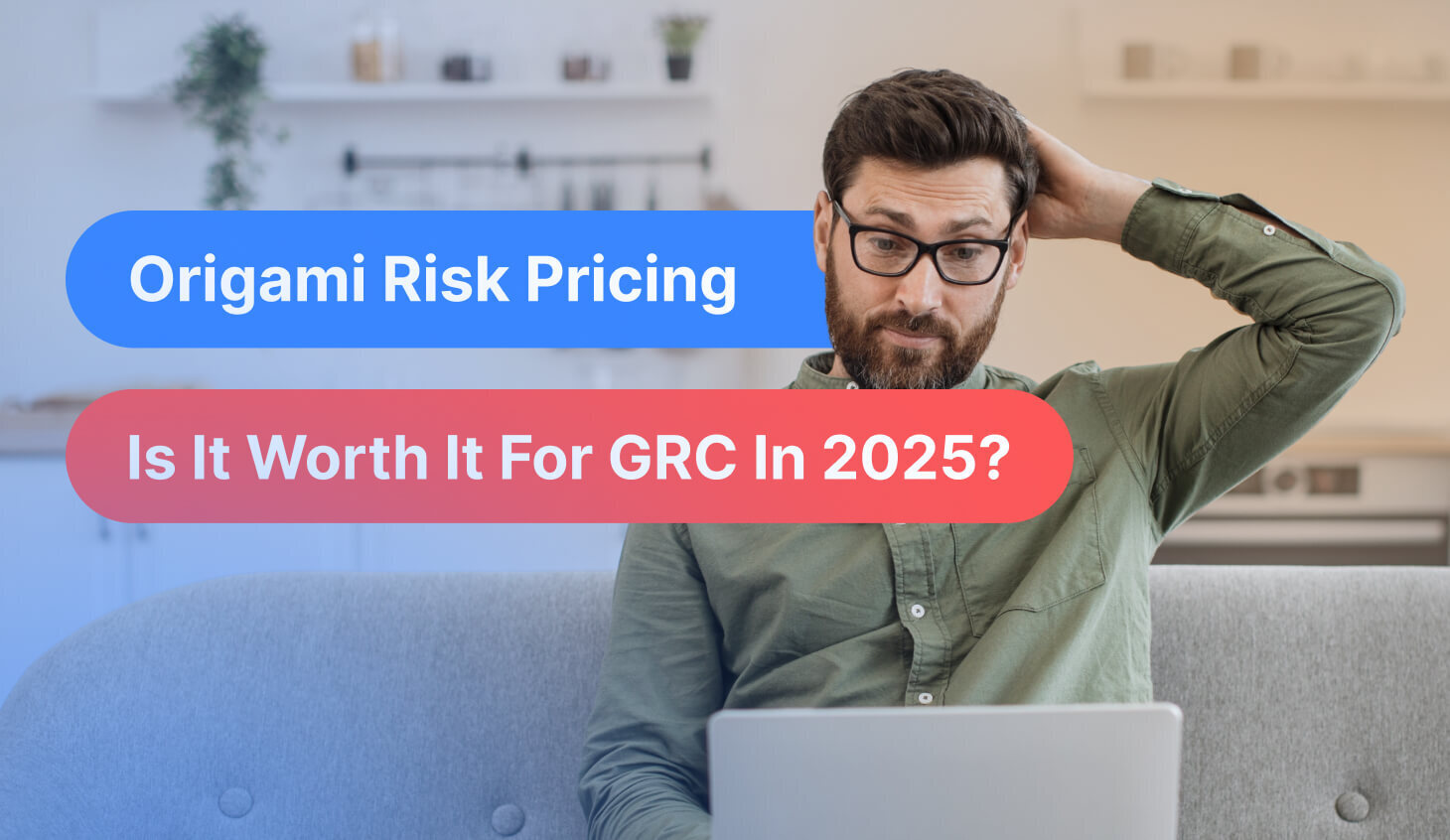In 2026, Origami Risk remains one of the most recognized names in enterprise risk and insurance management - but also one of the most complex when it comes to pricing.
While the platform has earned praise for its flexibility and depth across GRC, claims, and policy management, its custom-quote model often leaves buyers asking the same question: how much does Origami Risk really cost, and is it worth it?
With budgets tightening and GRC expectations evolving, transparency and speed now matter just as much as capability.
In this guide, I’ll make sure to unpack everything known about Origami Risk’s pricing model, explore what drives its costs, and compare it to a modern, no-code alternative built for clarity, speed, and scalability to help you evaluate Origami Risk’s offering more precisely.
Let’s dive in and see whether Origami Risk truly delivers value for money in 2026!
TL;DR
- Origami Risk remains a powerful enterprise GRC and insurance management platform in 2026, but its opaque pricing, lengthy setup, and complexity make it better suited for large organizations with deep budgets and dedicated admin teams.
- SmartSuite, by contrast, delivers the same GRC depth in a modern, no-code platform that’s fast to deploy, easy to customize, and fully transparent in cost, starting at just $12/user/month with a Free Forever plan and 14-day trial.
- If you want enterprise-grade governance, risk, and compliance capabilities without enterprise friction, SmartSuite is the simpler, faster, and more scalable choice.
Does Origami Risk offer a free plan or trial?
Origami Risk takes a different approach from most modern SaaS platforms.
There’s no free plan to explore on your own, and no instant “start your trial” button waiting on the homepage.
Instead, Origami Risk follows a demo-first model, where access begins only after you request a personalized walkthrough from the sales team.
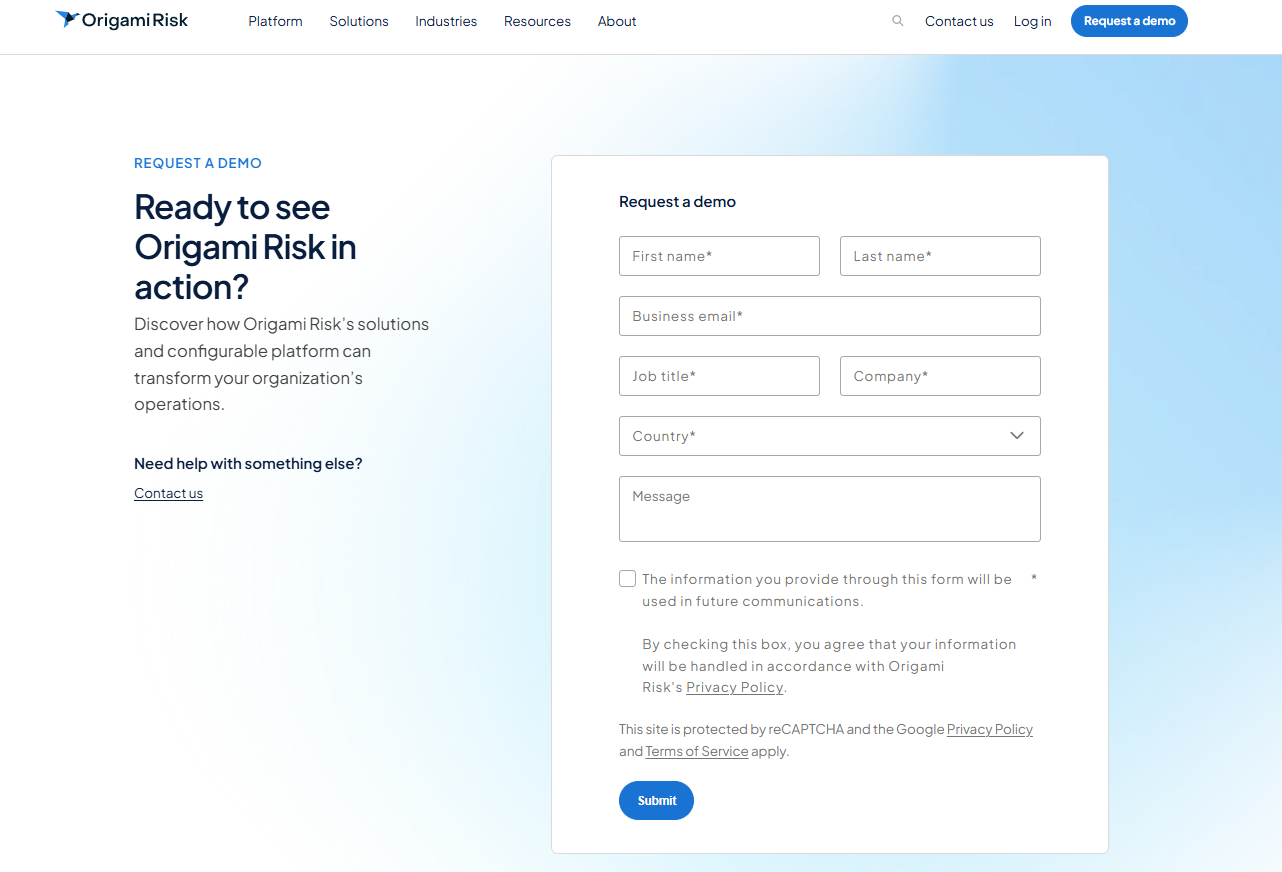
Source of image: Origami Risk.
That means you won’t be able to spin up an account, test key workflows, or see how the system fits your governance and compliance processes without going through a formal demo or proof-of-concept phase.
This approach isn’t unusual for enterprise software.
After all, Origami Risk is built for complex, multi-entity organizations that expect a guided evaluation and tailored configuration.
But it does make the early discovery process slower and less flexible for smaller teams or fast-moving compliance functions that prefer hands-on validation before committing.
In other words, Origami Risk doesn’t hand you the keys - it opens the door when you’re ready to talk.
So, if you’re looking for a platform you can explore immediately and learn by doing, this model may feel like a speed bump in your GRC evaluation journey.
Origami Risk pricing plans
Like many enterprise-grade GRC platforms, Origami Risk doesn’t publish fixed pricing or standard plan tiers on its website.
Instead, it uses a custom-quote model, where each client’s cost depends on the scope of implementation, number of users, and specific modules included in their deployment.
In practice, this means pricing is tailored to your organization’s needs, but it also means you won’t know what you’ll pay until late in the sales process.
For many teams, that makes early budgeting difficult, especially when trying to compare platforms side by side.
Origami Risk’s modular architecture spans a wide range of functions - including risk management, compliance, insurance, claims administration, policy management, and incident tracking - and each of these modules can potentially carry its own licensing and service costs.
That flexibility is part of the platform’s appeal, but it also contributes to significant pricing variation across customers.
As a result, for smaller teams or organizations seeking predictable, transparent pricing, this quote-based approach can feel opaque, especially compared to newer, no-code GRC platforms that publish clear, scalable plans upfront.
How much does Origami Risk actually cost?
Origami Risk doesn’t disclose pricing publicly, and all plans are built through custom quotes, but based on industry listings and user data, here’s what you can expect in 2026.
Third-party directories like Capterra and GoodFirms list Origami Risk as “Contact vendor” for pricing, while SelectHub mentions a possible starting range of around $500-$1,000.

Source: SelectHub.
However, that figure likely reflects a minimal configuration or legacy listing rather than a full enterprise deployment.
In reality, most mid-sized and large organizations can expect pricing to start in the five-figure-per-year range, with total costs rising significantly depending on the modules and scale of implementation.
Common pricing drivers in enterprise-grade GRC software, which likely affect Origami Risk pricing as well, include:
- Number of users and access levels (administrator vs. standard user).
- Modules or feature sets selected for your GRC program.
- Hosting environment, whether SaaS, private cloud, or on-premises.
- Implementation complexity, including integrations with ERP or HR systems.
- Support and service tier, such as premium or managed service packages.
Beyond annual licensing, setup and onboarding costs often add another layer, covering configuration, data migration, training, and ongoing support.
Given all that, it’s fair to say that Origami Risk most definitely falls in the more expensive end of the GRC software range.
Does Origami Risk provide good value for money in 2026?
When it comes to value, Origami Risk earns high marks from users who need a deep, reliable system to manage complex risk environments, but the investment and setup effort make it best suited for large, mature organizations.
Namely, many users highlight its breadth, as the platform covers not just GRC, but also insurance, claims management, EHS and policy administration.
Others praise its flexibility and structure, noting that it offers multiple ways to categorize claims, attach documentation, and maintain clear audit trails, which is critical in sensitive areas like insurance, damage claims, etc.
However, that same flexibility and scope that power Origami’s strength also introduce complexity:
- Several reviewers note that while the system is powerful, the interface could use a refresh, and some pre-built forms “aren’t as straightforward as they could be.”
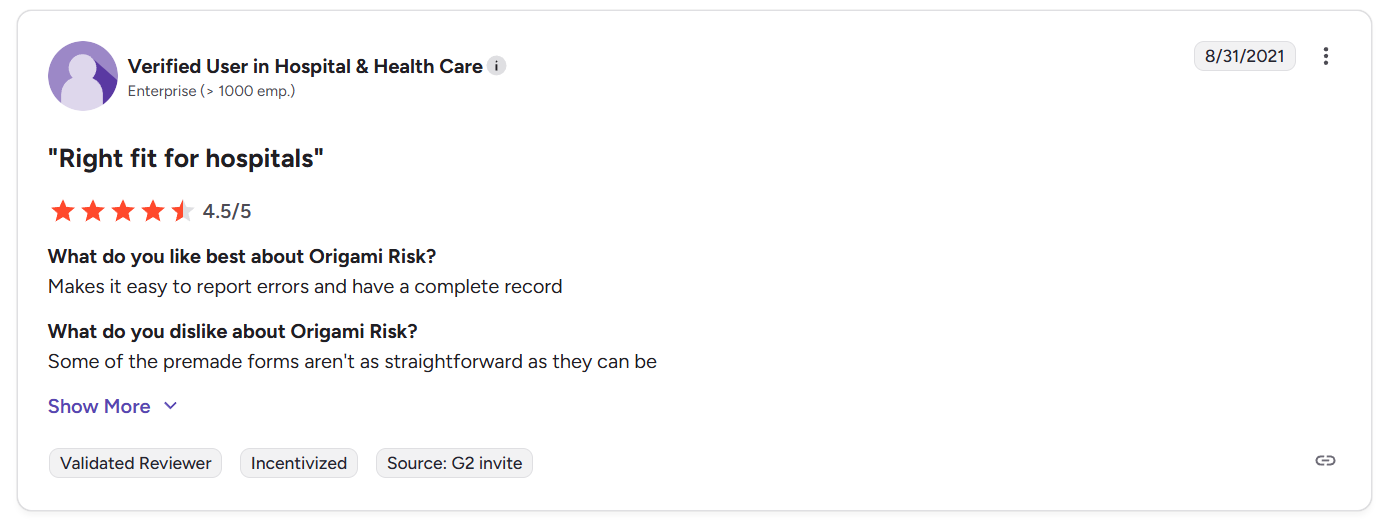
2. Some users feel that Origami Risk is difficult to personalize and tailor to their specific needs.

3. A few users also expressed frustration with Origami’s demo-only sales process, wishing it were easier to try the platform hands-on instead of going through a full enterprise evaluation cycle.
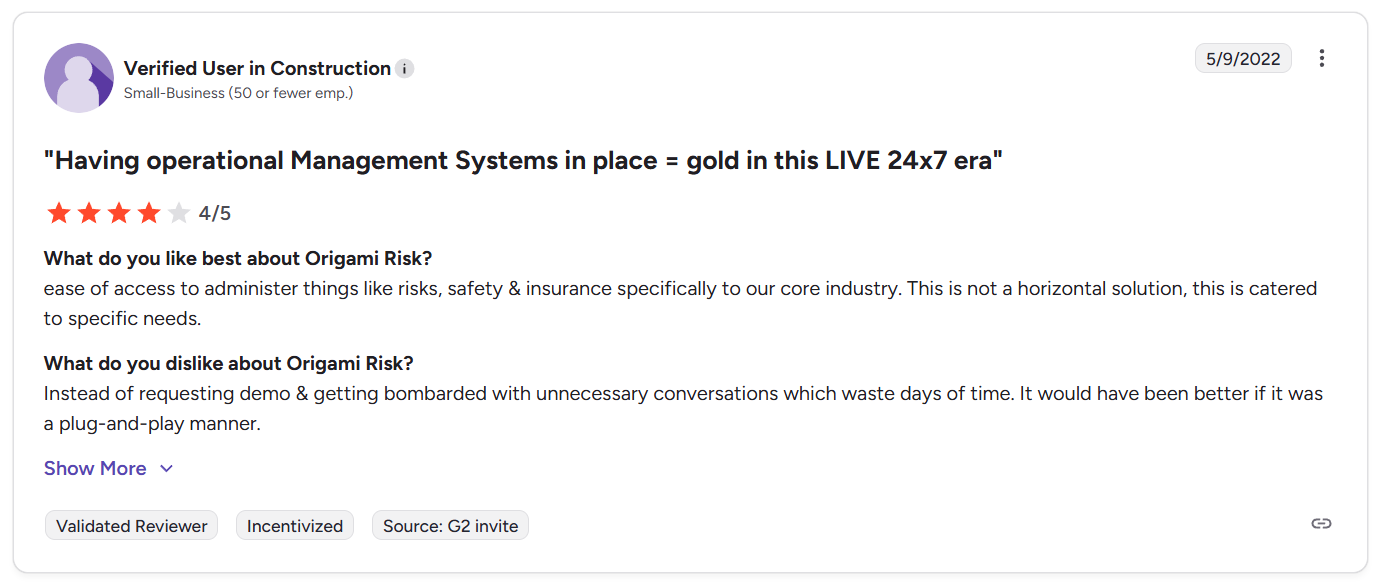
In short, Origami’s depth is undeniable, making it a strong fit for industries like healthcare, construction, and insurance where risk data lives across many systems.
At the same time, however, it requires a lot of time, training, IT involvement, and money to unlock its full potential.
This is why, for simpler GRC programmes (e.g., a small compliance team managing only a few risk registers), the breadth of Origami Risk could feel like “more than needed”, so the value may appear lower compared to lighter-weight tools.
In that case, newer, no-code GRC platforms with open pricing and instant onboarding may provide better agility and faster ROI in 2026.
Looking for an Origami Risk alternative?
If Origami Risk’s enterprise-level pricing, complex setup, or lack of a self-serve trial has you rethinking your GRC investment, you’re not alone.
Many modern compliance and risk teams are now looking for platforms that offer the same level of capability without the enterprise friction.
That’s where SmartSuite stands out.
SmartSuite delivers the governance, risk, and compliance depth you’d expect from an enterprise platform like Origami Risk, but in a modern, no-code environment that’s designed to launch fast, scale easily, and cost far less.

It’s purpose-built for teams that want to strengthen risk and compliance processes without waiting months for configuration or approvals.
Let’s look at what makes SmartSuite such a strong alternative in 2026.
1. Unified, no-code GRC platform
While Origami Risk divides its capabilities across separate modules for risk, insurance, and compliance, SmartSuite takes a unified approach, bringing every GRC process together in one connected workspace.

From risk assessments and incident tracking to policy reviews, audit workflows, and vendor management, everything lives in a single, no-code environment that updates in real time.
That means teams can see the full picture, including where risks are emerging, which controls are active, and how compliance activities are progressing, without juggling multiple systems or waiting for IT support.
Key advantages include:
- Centralized risk visibility: Map risks, controls, and mitigation plans together, so changes in one area automatically reflect across the framework.
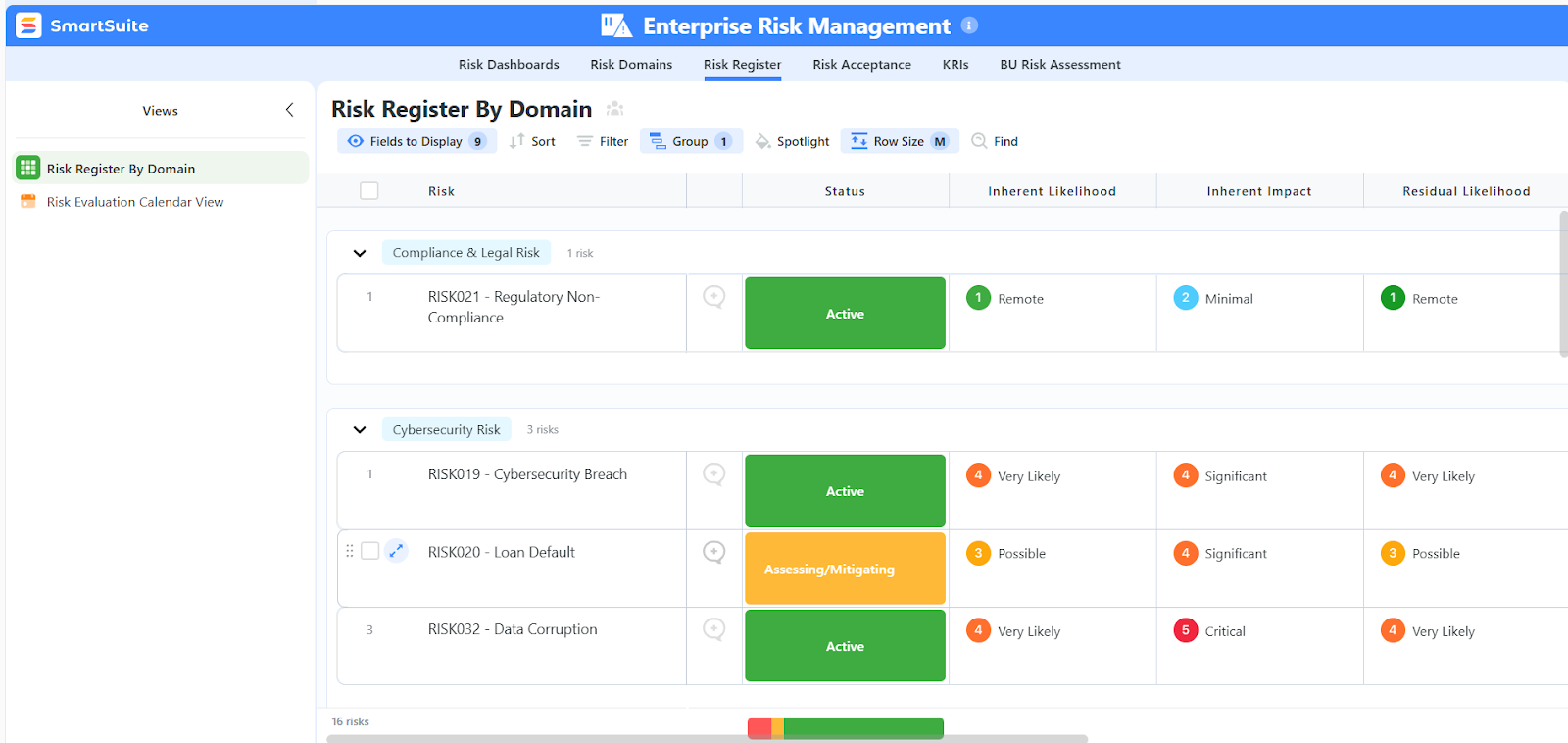
- Integrated workflows: When a risk changes status or an incident is logged, related policies, owners, and reports update automatically.
- Cross-functional collaboration: Team members across compliance, audit, operations, and risk can comment, tag colleagues, share files, and assign ownership directly within any record or dashboard, with every update visible instantly, eliminating the version confusion and communication gaps that slow down traditional systems.
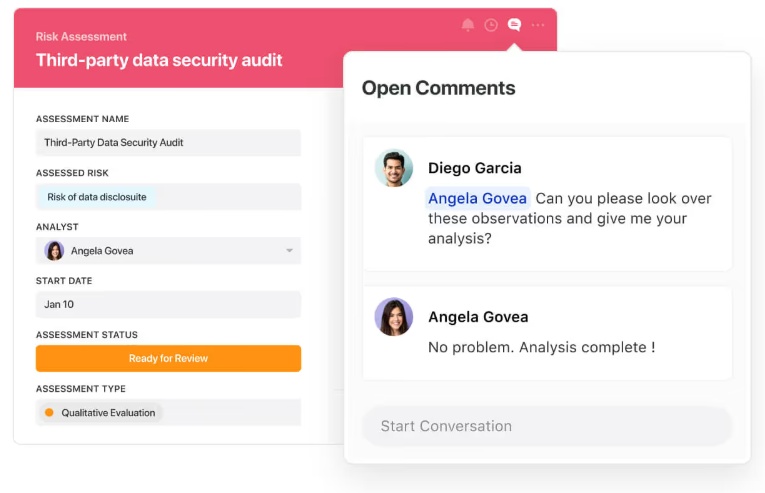
- Automation for accuracy and efficiency: Trigger alerts, escalations, or approval chains the moment key thresholds are met.
- Real-time reporting: Dashboards instantly visualize exposure, overdue actions, and audit results without relying on external BI tools.

In short, SmartSuite acts as a command centre for governance, risk, and compliance, giving you one place to plan, track, and report on everything that matters.
It delivers the power of enterprise GRC software like Origami Risk, but in a no-code, user-friendly platform that any team can launch in hours, not months.
2. Ready-made, customizable GRC templates
One of the biggest differences between Origami Risk and SmartSuite is how fast you can get started.
Where Origami often requires configuration and consultant-led setup, SmartSuite gives teams a head start with pre-built, best-practice GRC templates that can be tailored in minutes, with no coding or vendor intervention required.
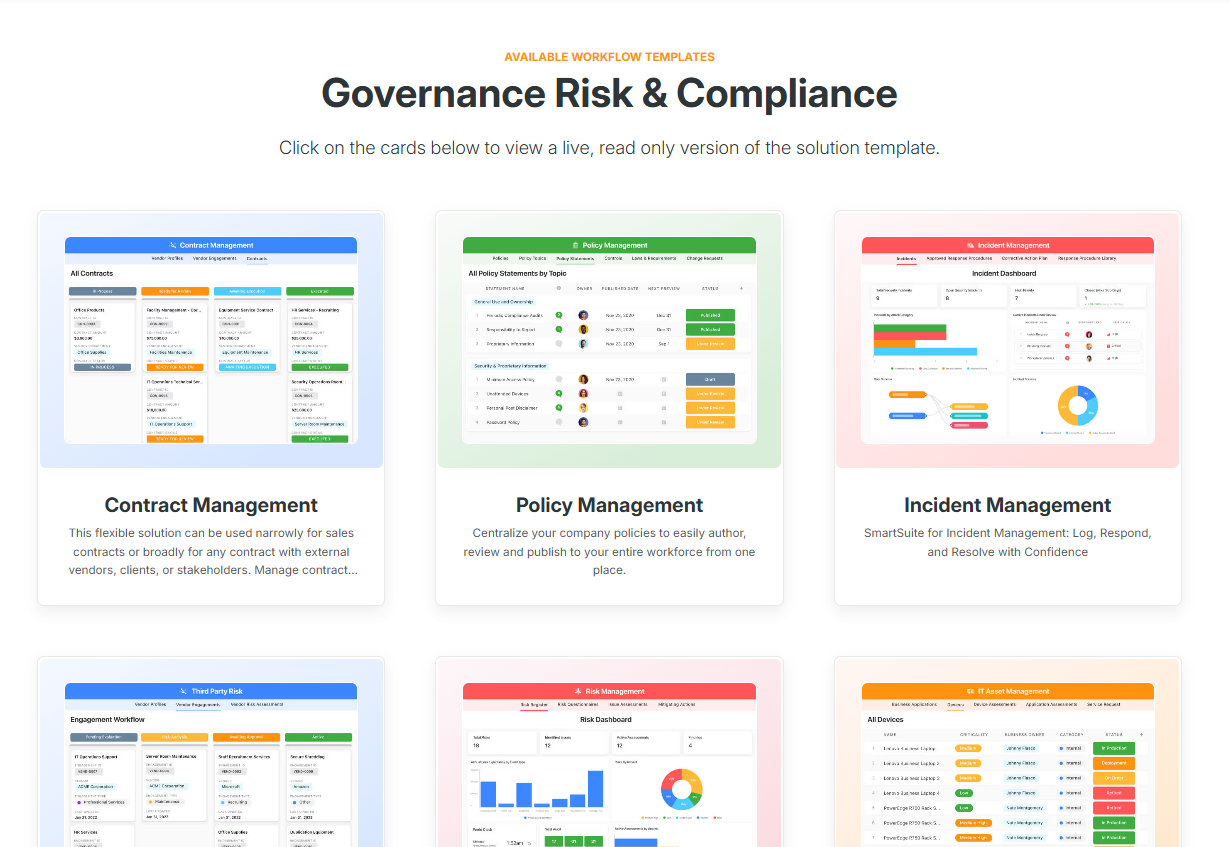
Each template is fully interactive and based on real-world governance frameworks, so you can plug it in, test it live, and adapt it to your organization’s structure instantly.
Popular SmartSuite GRC templates include:
- Risk Management: Identify, score, and monitor corporate risks with linked controls and automated mitigation tracking.
- Incident Management: Capture, assign, and resolve incidents with built-in workflows, audit trails, and escalation paths.
- Regulatory Change Management: Track evolving regulations, assess their potential impact, and document the actions your organization takes to remain compliant, all in one structured, auditable workflow.
- Policy Management: Centralize policies with clear version control, approvals, and organization-wide visibility.

- Third-Party & Vendor Risk: Consolidate vendor data, automate due diligence reviews, and monitor ongoing compliance with custom scoring.
- Audit & RCSA: Plan audits, assign ownership, and automate risk control self-assessments to maintain accountability.
- Business Continuity & Disaster Recovery: Build and test response plans to ensure operational resilience when disruptions occur.
Because every template can be customized using SmartSuite’s drag-and-drop builder, you can adjust fields, workflows, and dashboards to match your organization’s exact governance model.
3. Enterprise-grade security and scalability
While Origami Risk has long been trusted by large enterprises for its risk and insurance management depth, SmartSuite matches - and in many cases exceeds - those enterprise-grade security standards in a far more flexible, accessible package.
Every SmartSuite workspace is built with a defense-in-depth architecture that ensures sensitive governance and compliance data stays protected, whether you’re a growing mid-market team or a global organization managing multiple entities.
Here’s what that includes:
- SOC 2, ISO 27701, GDPR, and HIPAA compliance: SmartSuite adheres to leading international standards for data protection, privacy, and operational integrity.
- Encryption at rest and in transit: All data is protected end-to-end, meeting the same standards required by financial institutions and regulated industries.
- Role-based access control (RBAC): Define exactly who can view, edit, or approve each record, ensuring least-privilege access across departments.

- Audit logs and activity tracking: Maintain full visibility into every action taken across your GRC environment for easy traceability and compliance verification.
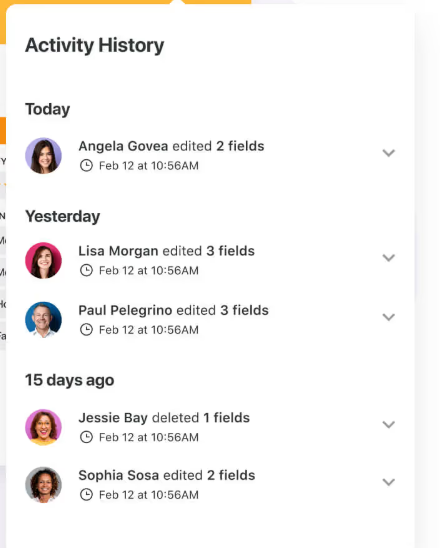
- Data loss prevention (DLP): Enterprise plans include advanced DLP features and customizable retention policies to protect sensitive assets.
- Regional data residency: Signature-tier customers can select hosting regions to meet jurisdictional or regulatory requirements.
For organizations used to rigid, consultant-driven systems like Origami Risk, SmartSuite provides the same enterprise confidence, without the enterprise overhead.
You get the flexibility to start small, expand fast, and meet any compliance standard along the way.
4. Easy customization and scalability
Every organization’s governance and compliance framework looks a little different, and SmartSuite is built to adapt to yours instantly, without a single line of code.
While Origami Risk often relies on vendor-led configuration and lengthy setup cycles, SmartSuite puts full control in your hands.
Using its intuitive no-code customization tools, teams can shape SmartSuite to mirror their exact workflows, risk models, and reporting standards in minutes.
Here are some of its key customization capabilities:
- 40+ flexible field types: Capture and organize information precisely the way your governance program requires, from numeric risk scores to dropdowns, attachments, and relational links.
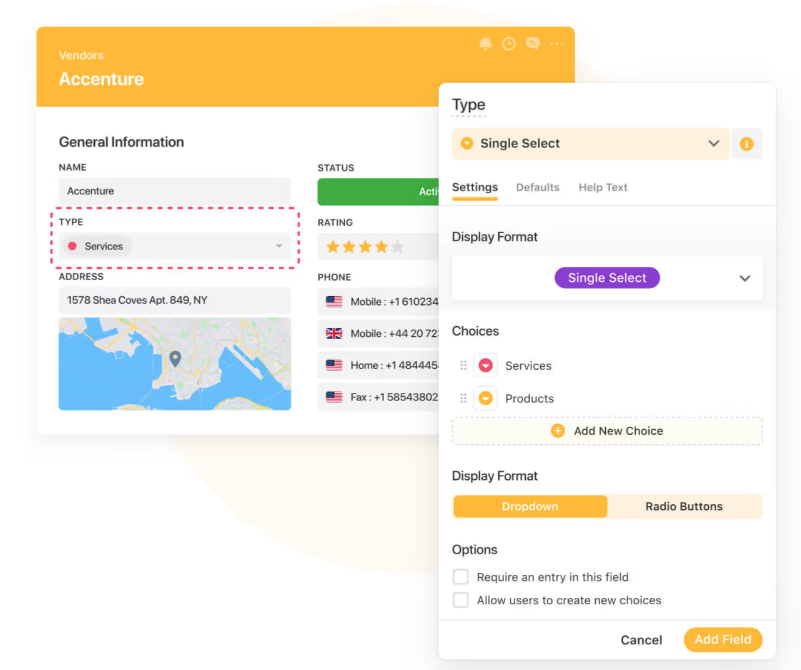
- Drag-and-drop workflow builder: Automate approvals, escalations, and notifications to keep reviews, assessments, and corrective actions on track.
- Custom KPIs and risk calculations: Define formulas and scoring logic to reflect your organization’s unique risk appetite or industry frameworks.
- Native integrations: Seamlessly connect SmartSuite with Slack, Gmail, Outlook, Microsoft Teams, Zapier, or any internal system through the REST API, ensuring data flows automatically across your tools.
The result is a platform that feels tailor-made for your organization - regardless of the vertical you’re in - but without the enterprise-grade cost or complexity.
How does SmartSuite’s pricing compare to Origami Risk’s?
One of the biggest pain points with Origami Risk is its opaque, quote-based pricing model.
Costs vary widely depending on the number of users, chosen modules, and implementation complexity, which makes early budgeting difficult and true cost transparency nearly impossible.
SmartSuite takes a very different approach.
Instead of custom quotes and multi-stage evaluations, it offers simple, predictable pricing that teams of any size can understand from day one.
First of all, the platform offers a Free Forever plan designed for individuals and small teams, giving access to core GRC templates, dashboards, real-time collaboration, and reporting features.
It supports up to 3 users, 5 solutions, and 1,000 records per solution, making it ideal for smaller teams or those piloting SmartSuite’s GRC capabilities before a full rollout.
And if you need more power, SmartSuite’s four paid tiers scale seamlessly with your organization’s growth and compliance maturity:
- Team: $12/user/month, includes everything in Free, plus unlimited solutions, 5,000 records per solution, 50GB of file storage, advanced collaboration tools, and a 30-day recycle bin.
- Professional: $30/user/month, includes everything in Team and adds advanced permissions, two-factor authentication, Gmail & Outlook integrations, AI features, and 100GB of file storage.
- Enterprise: $45/user/month, includes everything in Professional, plus audit logs, data loss prevention, up to 50,000 monthly API calls, and 500GB of file storage.
- Signature: Custom pricing, a fully tailored plan with no predefined limits, offering extended storage, API capacity, records, automations, and advanced enterprise security options such as SCIM provisioning and regional data residency.
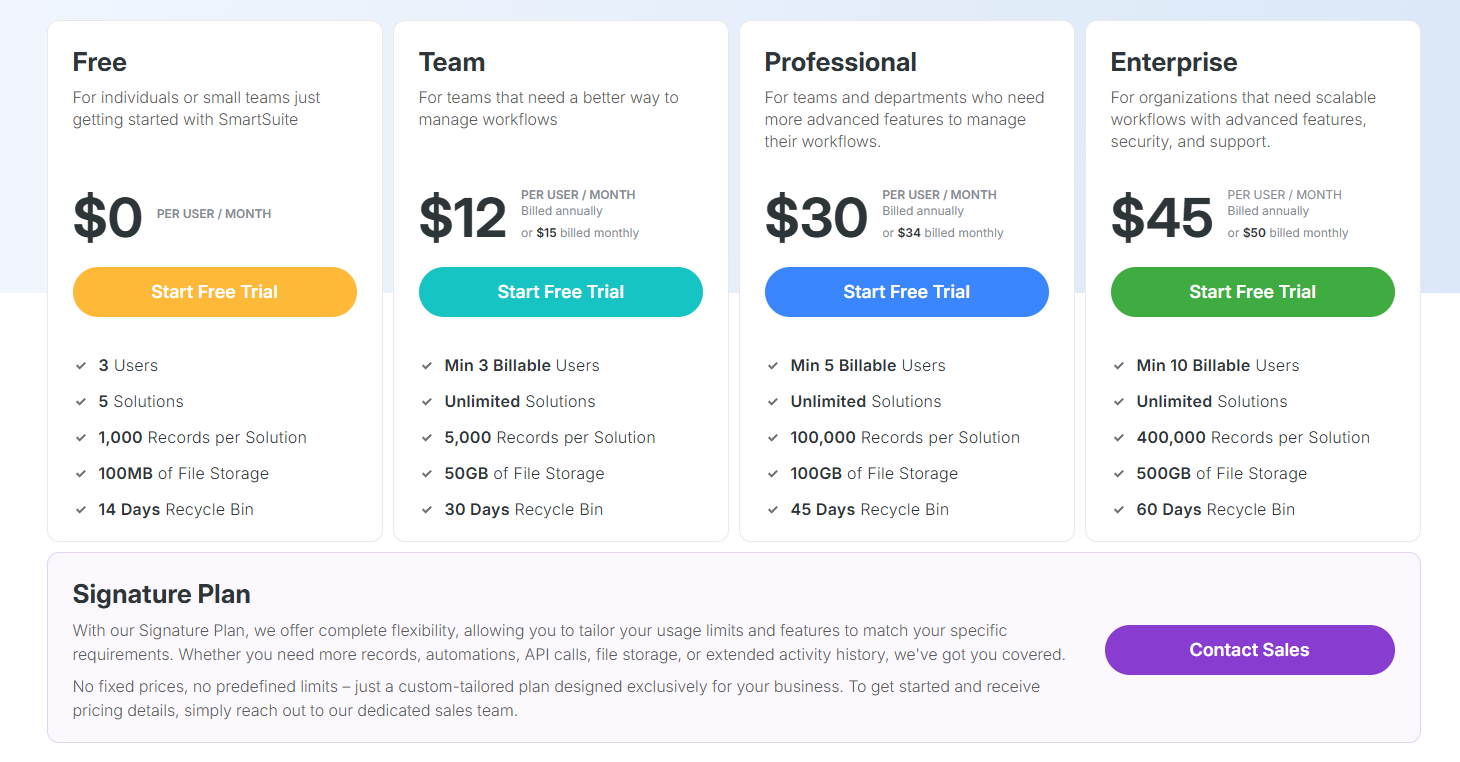
The first three paid plans include a 14-day free trial with no credit card required, allowing teams to explore SmartSuite’s full capabilities before committing.
How is SmartSuite different from Origami Risk?
Although Origami Risk and SmartSuite aim to solve similar problems, they come from two very different places.
Origami Risk reflects the traditional enterprise approach - powerful, highly configurable, and built for organizations that can afford long implementations and dedicated admin teams.
SmartSuite takes the opposite route: it reimagines GRC for today’s agile, cross-functional teams, blending enterprise-grade capability with the speed, clarity, and accessibility modern organizations now expect.
Here’s how the two platforms compare:
- Pricing transparency: Origami Risk follows a custom-quote model with no public pricing, meaning total costs remain unclear until late in the sales process. SmartSuite flips that approach with fully transparent, per-user pricing that starts at $12 per user/month, alongside a Free Forever plan and a 14-day free trial on all paid tiers. No hidden fees. No surprises.
- Implementation speed: Origami Risk typically involves a guided evaluation, consultant-led configuration, and lengthy onboarding cycles. SmartSuite lets teams start instantly with plug-and-play templates, drag-and-drop workflows, and no-code customization. You can go from sign-up to full deployment in hours - not months.
- Ease of use: Origami’s depth comes with complexity. Reviewers often praise its configurability but note a steeper learning curve, especially for non-technical users. SmartSuite’s modern interface and intuitive controls make risk and compliance management easy for everyone - whether you’re a first-time user or a seasoned GRC practitioner.
- Customization and flexibility: While Origami offers strong configurability, it often requires IT support or vendor input to implement changes, and it can feel a bit too rigid for some. SmartSuite puts that power directly in your hands with 40+ field types, a drag-and-drop workflow builder, custom KPIs, and native integrations with Slack, Outlook, Microsoft Teams, and more.
- Scalability and accessibility: Origami Risk is best suited for global enterprises with the resources to manage complex configurations. SmartSuite is built to scale from small teams to multinational organizations, combining enterprise-grade security (SOC 2, GDPR, ISO 27701, HIPAA) with flexible, modular growth.
The bottom line: Modern GRC shouldn’t be too complicated
Origami Risk continues to set the bar for enterprise-level risk and insurance management, but that strength often comes with strings attached.
Long implementations. Complex pricing. Heavy configuration.
For large organizations with the time and budget to manage all that, it can be worth it.
But for most teams in 2026, GRC needs have evolved.
They’re not just looking for power. They’re looking for clarity, simplicity, and control. They want to deploy quickly, collaborate easily, and understand exactly what they’re paying for.
That’s where SmartSuite comes in.
It combines the structure and reliability of traditional GRC software with the agility of a modern SaaS platform.
No coding, no consultants, no hidden costs - just a single, unified system for managing risk, compliance, and performance in real time.
If your goal is to make GRC easier, faster, and genuinely scalable, SmartSuite delivers everything Origami Risk promises, minus the complexity.
But why take just my word for it?
Start your free 14-day trial today and see for yourself just how effortless modern GRC can be.
⚠️ Disclaimer: This article was last updated on 21/11/2025 and if there's any misinterpretation of the information, please contact us and we will fact check it.
Read more
- SAP GRC Pricing: Is It Worth It In 2026? [Reviewed] - Find out whether SAP’s GRC suite still delivers enough value to justify its enterprise-level price tag in 2026.
- 10 Best Protecht Alternatives & Competitors [2026] - Explore the top GRC platforms that rival Protecht with stronger automation, better usability, and clearer pricing.
- Corporater Pricing: Is It Worth It For GRC In 2026? - See how Corporater’s flexible, enterprise-grade GRC platform compares to newer, no-code solutions built for speed and transparency.
- 10 Best Vanta Alternatives & Competitors In 2026 - From compliance automation to audit readiness, discover which Vanta alternatives offer smarter workflows and better scalability this year.
- 10 Best Audit Management Software & Tools In 2026 - Compare the leading audit management tools that simplify evidence collection, automate reporting, and keep compliance programs audit-ready.
- 10 Best ArcherIRM Alternatives For GRC In 2026 - Uncover the most capable and cost-effective alternatives to ArcherIRM for modern, agile governance and risk management.

Run your entire business on a single platform and stop paying for dozens of apps
- Manage Your Workflows on a Single Platform
- Empower Team Collaboration
- Trusted by 5,000+ Businesses Worldwide






